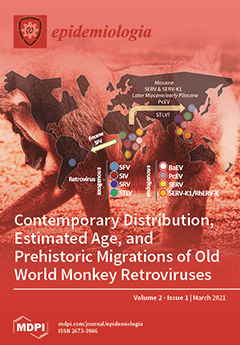Open AccessArticle
Quantifying Media Effects, Its Content, and Role in Promoting Community Awareness of Chikungunya Epidemic in Bangladesh
by
Mst. Marium Begum, Osman Ulvi, Ajlina Karamehic-Muratovic, Mallory R. Walsh, Hasan Tarek, Jailos Lubinda, Alfonso J. Rodriguez-Morales, Shehzad Sarfraz, Jesús A. Treviño C, Muhammad Yousaf Shad and Ubydul Haque
Cited by 1 | Viewed by 2475
Abstract
Background: Chikungunya is a vector-borne disease, mostly present in tropical and subtropical regions. The virus is spread by
Ae. aegypti and
Ae. albopictus mosquitos and symptoms include high fever to severe joint pain. Dhaka, Bangladesh, suffered an outbreak of chikungunya in 2017 lasting
[...] Read more.
Background: Chikungunya is a vector-borne disease, mostly present in tropical and subtropical regions. The virus is spread by
Ae. aegypti and
Ae. albopictus mosquitos and symptoms include high fever to severe joint pain. Dhaka, Bangladesh, suffered an outbreak of chikungunya in 2017 lasting from April to September. With the goal of reducing cases, social media was at the forefront during this outbreak and educated the public about symptoms, prevention, and control of the virus. Popular web-based sources such as the top dailies in Bangladesh, local news outlets, and Facebook spread awareness of the outbreak. Objective: This study sought to investigate the role of social and mainstream media during the chikungunya epidemic. The study objective was to determine if social media can improve awareness of and practice associated with reducing cases of chikungunya. Methods: We collected chikungunya-related information circulated from the top nine television channels in Dhaka, Bangladesh, airing from 1st April–20th August 2017. All the news published in the top six dailies in Bangladesh were also compiled. The 50 most viewed chikungunya-related Bengali videos were manually coded and analyzed. Other social media outlets, such as Facebook, were also analyzed to determine the number of chikungunya-related posts and responses to these posts. Results: Our study showed that media outlets were associated with reducing cases of chikungunya, indicating that media has the potential to impact future outbreaks of these alpha viruses. Each media outlet (e.g., web, television) had an impact on the human response to an individual’s healthcare during this outbreak. Conclusions: To prevent future outbreaks of chikungunya, media outlets and social media can be used to educate the public regarding prevention strategies such as encouraging safe travel, removing stagnant water sources, and assisting with tracking cases globally to determine where future outbreaks may occur.
Full article
►▼
Show Figures





